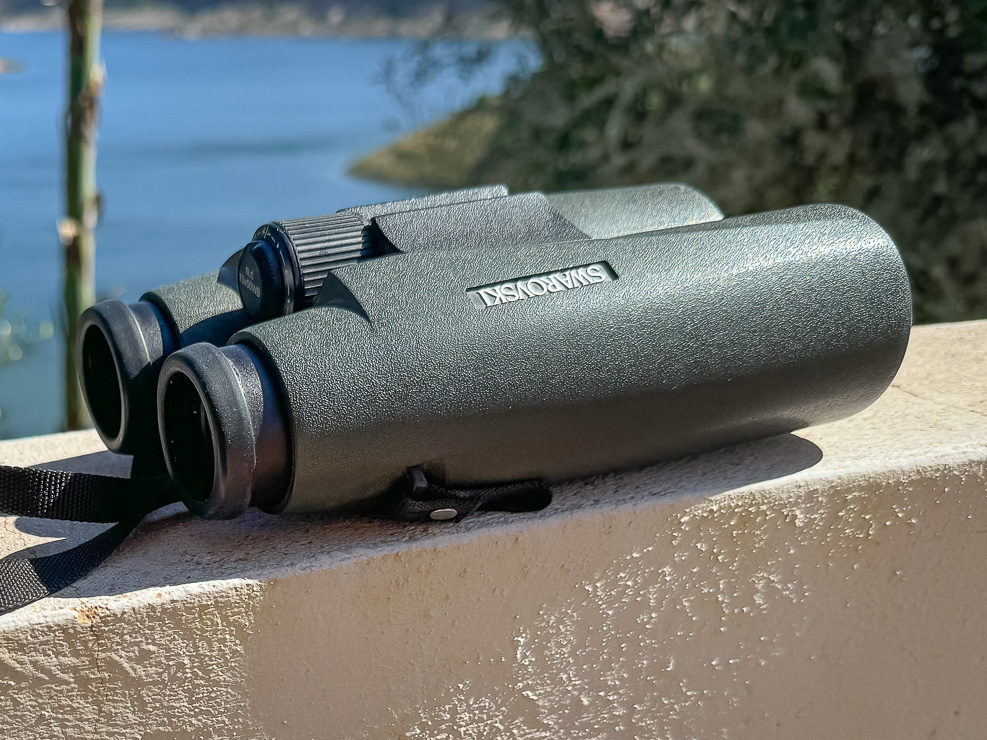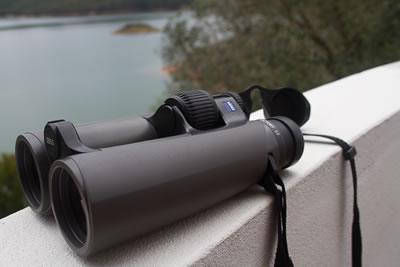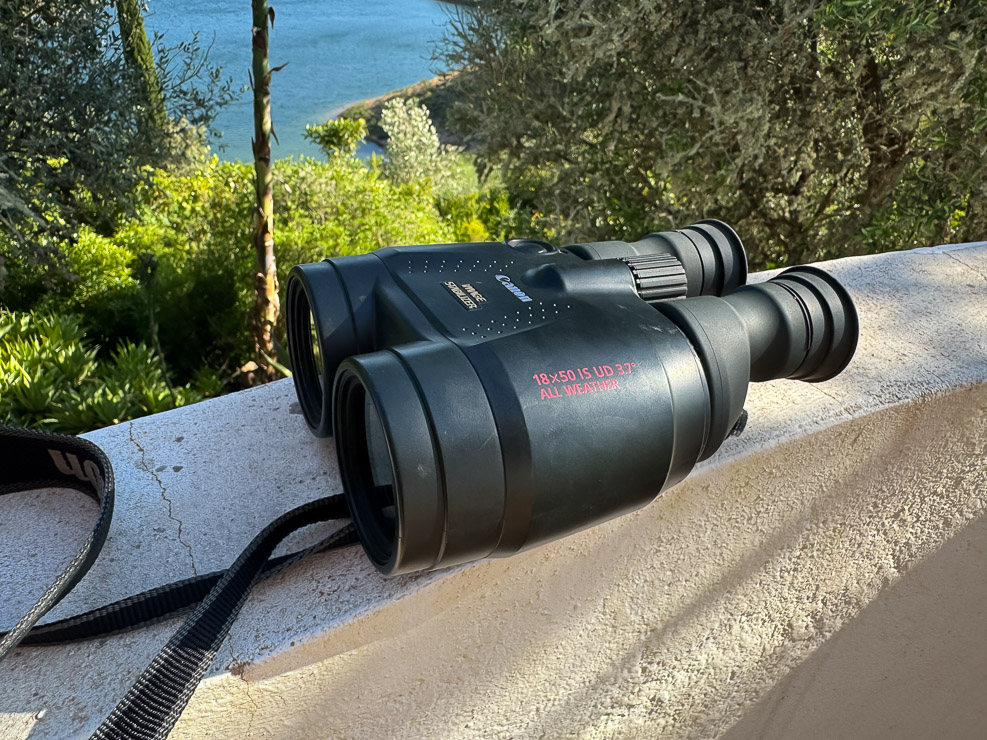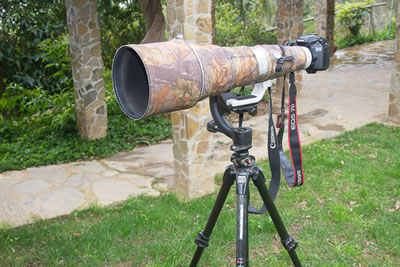Clothing
Suits you nicely sir!
A broad brimmed hat is essential. The sun can be pretty strong out here and keeping it off one's dome is a good idea.
Other than that wonderful piece of advice, dress as comfortably as possible. There's no real worry about the summer but during the winter I as a Guide have a fleece lined shirt and a zipped fleece lined jersey. These I find invaluable.
Throughout the year I also wear a mesh waistcoat with plenty of pockets for all those small accessories that I need as a photographer in the field. Being mesh it is both lightweight and breatheable, both essential characteristics for any fieldwork during the majority of the year.
Long socks are useful, especially after a wet Spring promotes a harvest of unlikeable ticks, and I always wear long trousers, never shorts - for which I am sure the general populace thanks me.
Shoes are possibly the most important item, and I prefer waterproof Timberlands with a decent grip.
Bins and 'scopes
Light in the lens, light in the hand or light on the pocket?
Our advice is to get the best you can afford!
Binoculars are definitely a piece of kit where the initial outlay affects your birding for years to come, so I reckon it's worth spending the extra buck, and the same could just as easily be said about telescopes if you're going to be doing the kind of birding that requires them.
Our optics of choice are Swarovski, Zeiss and Canon.
We chose other brands when we had limited funds, but we found they really weren't good enough for continuous work in the field, so at the beginning of the century we upgraded to Swarovski 10 X 50s whose ruggedness and quality we particularly found attractive.
However, these weren't light by any means, so in 2014 we splashed out on a pair of Zeiss Victory SF 10 X 42s which are stunning. They not only capture a huge amount of light but also weigh next to nothing and can focus down to one and a half meters, ideal for butterflies and dragonflies etc. With a three bridge design the're rugged too, and I can see us having years of success with them.
Then at the beginning of 2024 we also bought a pair of Canon 18 X 50 IS UD 3.7º with Image Stabiliser, which we now use instead of unwieldy 'scopes, and these are excellent for our work on the Plains or when trying to pick out species at the far end of a marsh. The Image Stabiliser function works perfectly - I never knew just how unsteady I was until I pressed that wonderful little button!
The choice is ultimately yours. Good equipment will set you back a fair amount, but the rewards come when the light's fading at the end of the day, you're on your chin-strap and there's that special species making a rare appearance ...
You can always try ours out in the field ... what better way to make such a vital decision?! We have Zeiss' Conquest and Terra models here too so there's a choice for every pocket and there really is no better way to see what the different models can give you than using them "for real". Beat's the hell out of a five minute trial at a fair or, heaven forbid, stepping out of a shop into the street!

The best I've found are our 10 X 50s from Swarovski. They're ultra-strong and have rattled around on the dashboard for 25 years now with not a scratch or a defect on them. Loads of light and very clear optics - you really can't buy better. and I would recommend Swaovski bins over any others. Nowadays ours appear antique when looking at the newer models, which are considerably lighter, but I've no complaints and would certainly buy another pair if the need ever arose. What's more, Swarovski offer an excellent cleaning and replacement parts service if one should need it.

These are our 10 X 42s from Zeiss. Lightweight, easy to handle and with an excellent focussing ability down to under 2mts, they're ideal for whatever aspect of nature watching you care to name. They're strong too and can take the knocks most of us throw at them.

These are our Canon 18 X 50s. They're not light by any means and the optics are not as good as a 'scope, but they're far easier to use than the latter and seem to be strong enough so far, while for picking out species a long way away they just can't be beaten - the image stabiliser works excellently.
Cameras and lenses
How seriously d´you take your birding?
It's when I started "collecting" lenses that I realised my birding had become serious.
Suffice to say I am now a pauper, but continue to have a lot of fun and take my "hobby" everywhere.
So, what do I use? I've always had Canons and that's not to in any way to disparage other makes, (I especially like pictures I've seen taken with Nikon equipment).
Anyway, for myself I have a EOS-1DX Mark II as a spare and an R3 with a 100-500 mm lens as my primary weapon. I've used many lenses in my time, (even an 800 mm prime at one time), but the setup I have now marries ease of use with excellent results.


For macro work I use a Canon EF 100 mm f2.8 L.
For landscapes I use a wide angled EFS 10 - 22 mm.
I try to avoid switching lenses in the field as dust invariably enters, so I keep one 1DX on the 500 across my lap, the other with the 400 mm for faster moving objects, one 7D rigged for macro and the other for wide angle.
For video I use an Olympus Tough. No good for long distance but beautifully rugged, waterproof and fits in one’s pocket.

Extras

Essential extra #1 is a decent tripod, (and I'm lucky enough to have two), and a monopod.
The tripods are a light carbon fibre Manfrotto 055CXPro4 with a Benro GH2 gimbal head, (which I find excellent, especially when using the heavy 500 mm), and a heavier, older Manfrotto, the 144Bird, (which has proved its worth through over 20 years of hard knocks and use).

The Monopod is a carbon fibre Manfrotto with the FDS, (Fluid Drag System), foot and a Gitzo Ball head-mounting. A good combination that makes for an excellent piece of kit.

Another piece of equipment that I use nowadays and which I find essential is the Cotton Carrier "Camera vest". This leaves my hands free while carrying a camera and lens securely on my chest with another on my hip with the weight spread onto my shoulders and hip instead of my neck. I cannot rate this product highly enough, though it does make me, (even if not my beautiful model), look ridiculously Rambo-esque.
